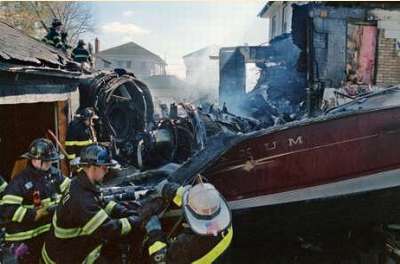Mon, May 31, 2004
Unrelated To AAL New York Crash, But Just As Deadly
It may not have been the fatal flaw in American Airlines Flight
587's 2001 crash, but it could be a big problem for future flights
of the Airbus A300-600.

According to the New York Times, the NTSB has turned up a flaw
in the rudder design of the A300. Investigators say the rudder of
the A300-600 can swing too far during rapid acceleration, causing
severe tail damage or even delamination of the aircraft. The NTSB
said the governor that limits the rudder's movements -- the
"limiter" -- didn't keep up with rapid changes in the speed of the
aircraft.
 Airbus apparently was ready for the
finding. Spokeswoman Mary Ann Greczyn said in a statement that a
complete redesign of the empennage was in order. "We expected it
was coming. It will add another level of safety for those
extraordinarily rare times when there are rapid changes in air
speed due to aircraft upset."
Airbus apparently was ready for the
finding. Spokeswoman Mary Ann Greczyn said in a statement that a
complete redesign of the empennage was in order. "We expected it
was coming. It will add another level of safety for those
extraordinarily rare times when there are rapid changes in air
speed due to aircraft upset."
At the focal point of the finding wasn't the November 12, 2001
crash of American Airlines Flight 587, but another incident
involving an American Airlines A300-600 in 1997. In that incident,
a flight crew member was injured when the aircraft, flying near
West Palm Beach (FL), dramatically increased velocity. The NTSB
said the limiter couldn't keep up with the rapid change in
airspeed. The aircraft subsequently lost about 3000 feet in
altitude as the crew struggled to regain control.
In its investigation of the 1997 incident, the NTSB said the
limiter system simply couldn't keep up with airspeed changes of
more than 2.4 knots/second. The A300-600 flying near West Palm
seven years ago was accelerating at approximately 10
knots/second.
American Airlines has been locked in a bitter battle with Airbus
over liability in the 2001 crash at Belle Harbor (NY). All 260
people on board Flight 587, as well as five people on the ground,
were killed after the copilot, apparently fighting severe wake
turbulence, swung the rudder drastically from side to side. As a
result, the NTSB says the vertical stabilizer departed the
aircraft, leading to the crash.

Now, American says it is already training its A300-600 pilots to
avoid "the specific shortcomings in the Airbus A300-600 rudder
control system that the NTSB recommendation involves."
More News
From 2023 (YouTube Version): Legacy of a Titan Robert (Bob) Anderson Hoover was a fighter pilot, test pilot, flight instructor, and air show superstar. More so, Bob Hoover was an i>[...]
Get The Latest in Aviation News NOW on Instagram Are you on Instagram yet? It's been around for a few years, quietly picking up traction mostly thanks to everybody's new obsession >[...]
Aero Linx: B-52H Stratofortress The B-52H Stratofortress is a long-range, heavy bomber that can perform a variety of missions. The bomber is capable of flying at high subsonic spee>[...]
Altimeter Setting The barometric pressure reading used to adjust a pressure altimeter for variations in existing atmospheric pressure or to the standard altimeter setting (29.92).>[...]
"Knowing that we play an active part in bettering people's lives is extremely rewarding. My team and I are very thankful for the opportunity to be here and to help in any way we ca>[...]
 Classic Aero-TV: Remembering Bob Hoover
Classic Aero-TV: Remembering Bob Hoover ANN FAQ: Follow Us On Instagram!
ANN FAQ: Follow Us On Instagram! ANN's Daily Aero-Linx (05.15.24)
ANN's Daily Aero-Linx (05.15.24) ANN's Daily Aero-Term (05.15.24):Altimeter Setting
ANN's Daily Aero-Term (05.15.24):Altimeter Setting Aero-News: Quote of the Day (05.16.24)
Aero-News: Quote of the Day (05.16.24)





